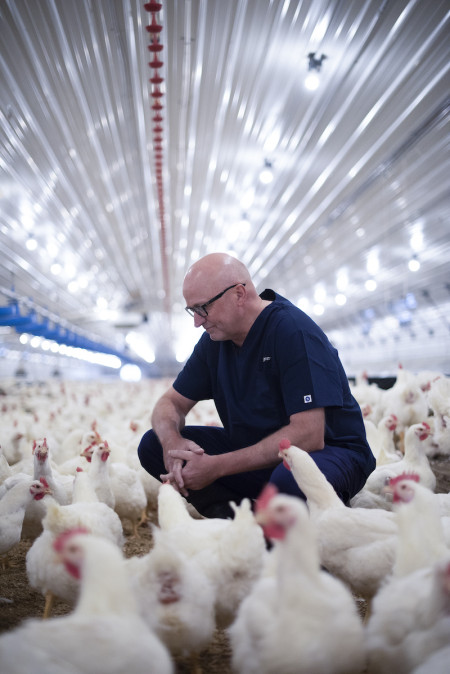The broiler of tomorrow: Navigating challenges, embracing innovation

In July, our CEO Jan Henriksen addressed the attendees of the Watt Global Chicken Marketing Summit. We’re pleased to present a synopsis of the market insights he shared.
The poultry industry has grown robustly over the past 60 years, producing over 25 million tons of meat in some regions to meet increasing demand [source: UN Food and Agriculture Organization (FAO)]. Chicken’s popularity stems from its health benefits, affordability and versatility. Poultry surpassed beef consumption in the 1990s and recently overtook pork (source: FAO statistics database). To sustain this growth and continue to feed the world with a nutritious, sustainable protein, we must skillfully navigate market challenges and embrace innovation to enhance welfare, sustainability, food safety, and security.
Seizing opportunities
Global meat protein consumption is projected to increase 14% by 2030, with poultry expected to rise by 17.8%. This growth offers significant opportunities for innovation in welfare and sustainability. To seize these opportunities, we must continue to prioritize:
Balanced breeding. For decades, Aviagen has successfully bred healthy, efficient birds with optimal welfare traits. These birds promote sustainability by using fewer resources and emitting lower harmful emissions.
Biodiversity. By maintaining a broad gene pool, we enable the world’s poultry producers to meet current and future market demands. Close collaboration with our customers ensures today’s trends are met and tomorrow’s needs anticipated.
Breeding innovation. We leverage the latest technology, such as feed stations and computed tomography (CT), to refine our genetic selection processes. Genomics technology further enhances our trait selection accuracy.
Breeding efficiency. Our improvements in Feed Conversion Ratio (FCR) since 1979 have reduced the carbon footprint of poultry production by 1% per year. At the same time, they have elevated economic sustainability by lowering feed costs, the greatest expense for poultry businesses.
Enhancing cardiovascular and leg health. By leveraging technologies like the lixiscope and oximeter, we have identified birds at risk for leg defects and cardiovascular issues since the 1970s. Strengthening leg health and cardiovascular function improves overall bird welfare and performance.
Adaptability. Working closely with our customers, we perform regular field testing under various climatic and growing conditions to make sure our birds thrive in diverse production environments.
Spanning the socioeconomic spectrum
The world’s population is projected to reach 8.5 billion by 2030, 9.7 billion by 2050, and 10.4 billion by 2100. However, this growth is expected to eventually decline due to falling global fertility rates (source: the United Nations). Rapid urbanization and rising incomes in developing countries will lead to increased demand for high-quality animal protein sources like poultry. Poultry offers considerable nutritional benefits and is both affordable and readily available, making it an ideal protein source for undernourished populations.
Challenges ahead
 The poultry industry faces numerous challenges, including managing animal diseases, improving welfare and quality, competing with other protein sources, and addressing climate change.
The poultry industry faces numerous challenges, including managing animal diseases, improving welfare and quality, competing with other protein sources, and addressing climate change.
Global stumbling blocks. The industry faces ongoing obstacles from disasters, both natural and man-made. Recent events like the COVID pandemic exposed vulnerabilities in the poultry supply chain. Other challenges include wars, trade disruptions, misinformation, and regulatory changes, underscoring the need for resilience, flexibility and innovation.
Bird welfare. Focusing on bird welfare is crucial. Not only is looking after the well-being of our birds the right thing to do, but consumers demand it. Moreover, good welfare is good business, as healthy birds perform better, have greater livability, stronger immunity and better feed efficiency. Aviagen is committed to bird welfare, with a balanced selection process focusing on performance, health and welfare, and sustainability.
Food safety. Ensuring food safety is essential for feeding the world. Aviagen applies strict biosecurity protocols, and leverages the latest innovations, including technologies to monitor bird behavior and well-being, automation, and Artificial Intelligence (AI) to strengthen supply safety. We also invest in training and share best practices across the industry.
Attracting talent. Attracting and retaining qualified talent is vital to the sustainability of our industry. It is important that our industry engage regularly with up-and-coming poultry professionals, offering internships, and collaborating with educational institutions.
Embracing innovation
To navigate current and future challenges, Aviagen will continue to collaborate with industry allies, embrace innovation, and continuously improve. This includes adopting technology for better supply chain management, strengthening bird health and welfare, and leveraging data analytics for informed decision-making.
By proactively leading change, we can drive positive transformation within the industry. Together, we can shape the future of poultry production with the broiler of tomorrow, ensuring sustainable growth for years to come.